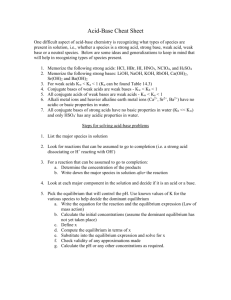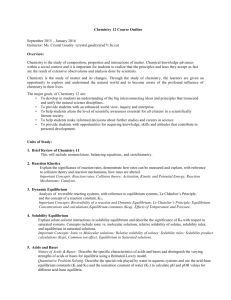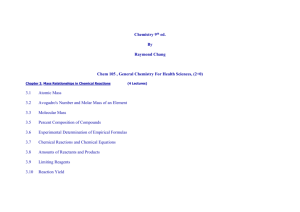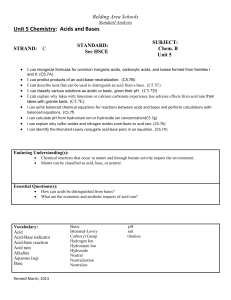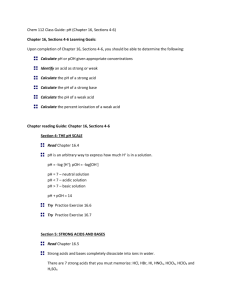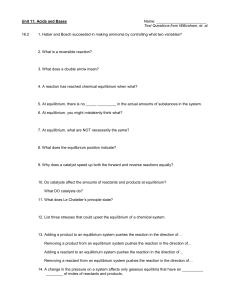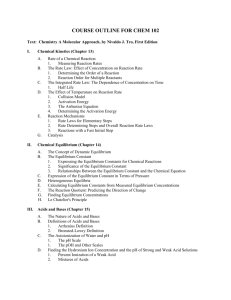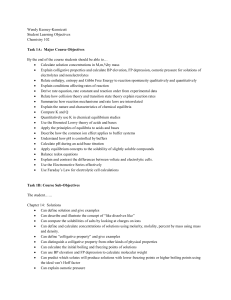Exam questions from General Chemistry 2009 Physical properties
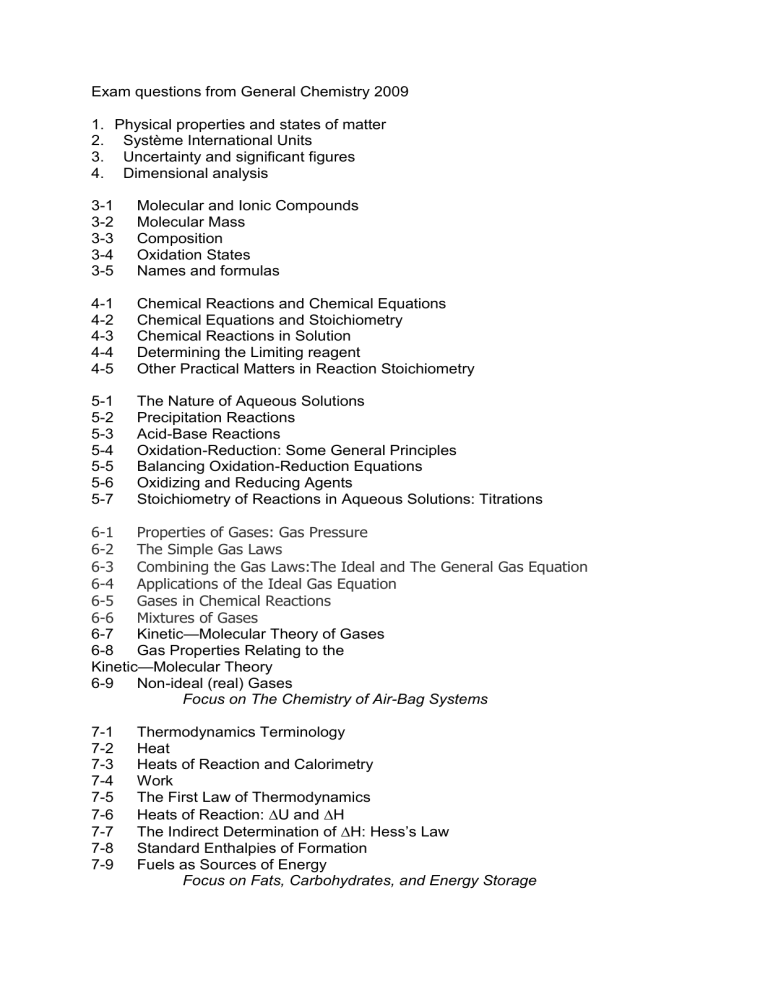
Exam questions from General Chemistry 2009
1. Physical properties and states of matter
2. Système International Units
3. Uncertainty and significant figures
4. Dimensional analysis
3-1 Molecular and Ionic Compounds
3-2 Molecular Mass
3-3 Composition
3-4 Oxidation States
3-5 Names and formulas
4-1 Chemical Reactions and Chemical Equations
4-2 Chemical Equations and Stoichiometry
4-3 Chemical Reactions in Solution
4-4 Determining the Limiting reagent
4-5 Other Practical Matters in Reaction Stoichiometry
5-1 The Nature of Aqueous Solutions
5-2 Precipitation Reactions
5-3 Acid-Base Reactions
5-4 Oxidation-Reduction: Some General Principles
5-5 Balancing Oxidation-Reduction Equations
5-6 Oxidizing and Reducing Agents
5-7 Stoichiometry of Reactions in Aqueous Solutions: Titrations
6-1 Properties of Gases: Gas Pressure
6-2 The Simple Gas Laws
6-3 Combining the Gas Laws:The Ideal and The General Gas Equation
6-4 Applications of the Ideal Gas Equation
6-5 Gases in Chemical Reactions
6-6 Mixtures of Gases
6-7 Kinetic —Molecular Theory of Gases
6-8 Gas Properties Relating to the
Kinetic
—Molecular Theory
6-9 Non-ideal (real) Gases
Focus on The Chemistry of Air-Bag Systems
7-1 Thermodynamics Terminology
7-2 Heat
7-3 Heats of Reaction and Calorimetry
7-4 Work
7-5 The First Law of Thermodynamics
7-6 Heats of Reaction:
U and
H
7-7 The Indirect Determination of
H: Hess’s Law
7-8 Standard Enthalpies of Formation
7-9 Fuels as Sources of Energy
Focus on Fats, Carbohydrates, and Energy Storage
13-1 Intermolecular Forces and some Properties of Liquids
13-2 Vaporization of Liquids: Vapor Pressure
13-3 Some Properties of Solids
13-4 Phase Diagrams
13-5 Van der Waals Forces
13-6 Hydrogen Bonding
13-7 Chemical Bonds as Intermolecular Forces
13-8 Crystal structures
13-8 Energy Changes in the Formation of Ionic Crystals
Focus on Liquid Crystals
14-1 Types of Solutions: Some Terminology
14-2 Solution Concentration
14-3 Intermolecular Forces and the Solution Process
14-4 Solution Formation and Equilibrium
14-5 Solubilities of Gases
14-6 Vapor Pressure of Solutions
14-7 Osmotic Pressure
14-8 Freezing-Point Depression and Boiling-Point Elevation of Nonelectrolyte solutions.
14-9 Solutions of Electrolytes
14-10 Colloidal Mixtures
15-1 The Rate of a Chemical Reaction
15-2 Measuring Reaction Rates
15-3 Effect of Concentration on Reaction Rates: The Rate Law
15-4 Zero-Order Reactions
15-5 First-Order Reactions
15-6 Second-Order Reactions
15-7 Reaction Kinetics: A Summary
15-8 Theoretical Models for Chemical Kinetics
15-9 The Effect of Temperature on Reaction Rates
15-10 Reaction Mechanisms
15-11 Catalysis
16-1 Dynamic Equilibrium
16-2 The Equilibrium Constant Expression
16-3 Relationships Involving Equilibrium Constants
16-4 The Significance of the Magnitude of an Equilibrium Constant
16-5 The Reaction Quotient, Q : Predicting the Direction of a Net Change
16-6
Altering Equilibrium Conditions: Le Châtelliers Principle
16-7 Equilibrium Calculations: Some Illustrative Examples
Focus On The Nitrogen Cycle and the Synthesis of Nitrogen Compounds
17-1 The Arrhenius Theory: A Brief Review
17-2 Brønsted-Lowry Theory of Acids and Bases
17-3 The Self-Ionization of Water and the pH Scale
17-4 Strong Acids and Strong Bases
17-5 Weak Acids and Weak Bases
17-6 Polyprotic Acids
17-7 Ions as Acids and Bases
17-8 Molecular Structure and Acid-Base Behavior
17-8 Lewis Acids and Bases
18-1 The Common-Ion Effect in Acid-Base Equilibria
18-2 Buffer Solutions
18-3 Acid-Base Indicators
18-4 Neutralization Reactions and Titration Curves
18-5 Solutions of Salts of Polyprotic Acids
18-6 Acid-Base Equilibrium Calculations: A Summary
19-1 The Solubility Product Constant, K sp
19-2 The Relationship Between Solubility and K sp
19-3 The Common-Ion Effect in Solubility Equilibria
19-4 Limitations of the K sp
Concept
19-5 Criteria for Precipitation and Its Completeness
19-6 Fractional Precipitation
19-7 Solubility and pH
19-8 Equilibria Involving Complex Ions
19-9 Qualitative Cation Analysis
Focus On Shells, Teeth, and Fossils
20-1 Spontaneity: The Meaning of Spontaneous Change
20-2 The Concept of Entropy
20-3 Evaluating Entropy and Entropy Changes
20-4 Criteria for Spontaneous Change:
The Second Law of Thermodynamics
20-5 Standard Fee Energy Change, Δ G °
20-6 Free Energy Change and Equilibrium
20-7
Δ
G
° and
K eq as Functions of Temperature
20-8 Coupled Reactions
Focus On Coupled Reactions in Biological Systems
21-1 Electrode Potentials and Their Measurement
21-2 Standard Electrode Potentials
21-3 E cell
, Δ G , and K eq
21-4 E cell as a Function of Concentration
21-5 Batteries: Producing Electricity Through
Chemical Reactions.
21-6 Corrosion: Unwanted Voltaic Cells
21-7 Electrolysis: Causing Non-spontaneous Reactions to Occur
21-8 Industrial Electolysis Processes
Focus On Membrane Potentials
9-1 Electromagnetic Radiation
9-2 Atomic Spectra
9-3 Quantum Theory
9-4 The Bohr Atom
9-5 Two Ideas Leading to a New Quantum Mechanics
9-6 Wave Mechanics
9-7 Interpreting and Representing Orbitals of the Hydrogen Atom
9-8 Quantum Numbers and Orbitals
9-9 Electron Spin
9-10 Multi-electron Atoms
9-11 Electron Configurations
9-12 Electron Configurations and the Periodic Table
10-1 Classifying the Elements: The Periodic Law and the Periodic Table
10-2 Metals and Nonmetals and Their Ions
10-3 The Sizes of Atoms and Ions
10-4 Ionization Energy
10-5 Electron Affinity
10-6 Magnetic Properties
10-7 Periodic Properties of the Elements
11-1 Lewis Theory: An Overview
11-2 Covalent Bonding: An Introduction
11-3 Polar Covalent Bonds
11-4 Writing Lewis Structures
11-6 Exceptions to the Octet Rule
11-7 The Shapes of Molecules
11-8 Bond Order and Bond Lengths
11-9 Bond Energies
12-1 What a Bonding Theory Should Do
12-2 Introduction to the Valence-Bond Method
12-3 Hybridization of Atomic Orbitals
12-4 Multiple Covalent Bonds
12-5 Molecular Orbital Theory
12-6 Delocalized Electrons: Bonding in the Benzene Molecule
12-7 Bonding in Metals
Focus on Photoelectron Spectroscopy
